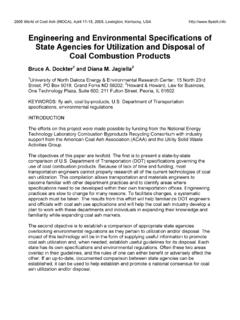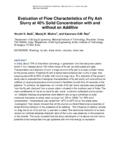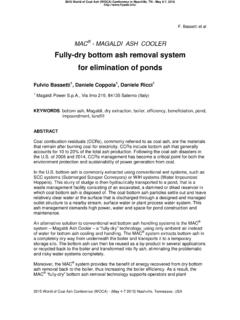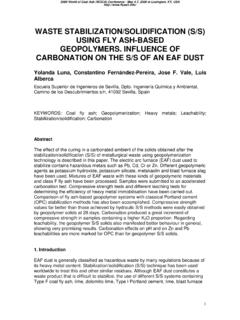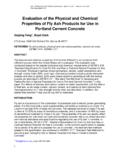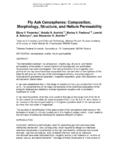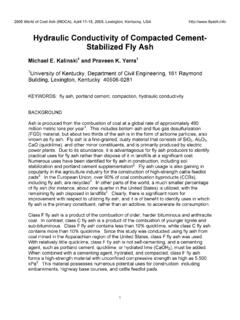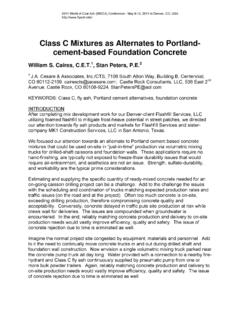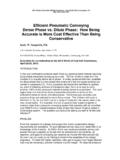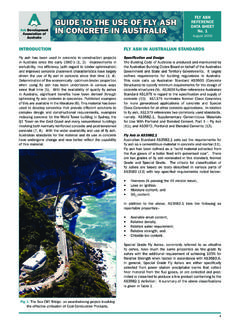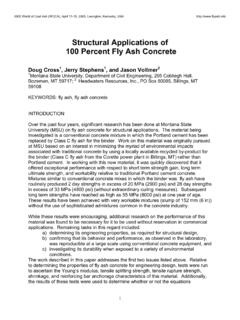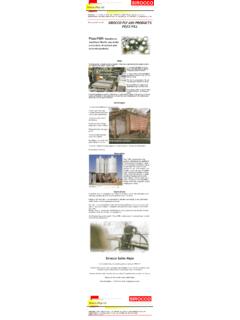Transcription of Evaluation of Liquefaction Potential at Fly Ash Storage ...
1 1 Evaluation of Liquefaction Potential at Fly Ash Storage Reservoirs Pedro J Amaya1, Donald Fuller2, Jeffrey Dingrando2, Vik Gautam3, James Moseley3, Paul Sabatini4, Nicholas Perrotta5, Christopher Hardin5 1 Civil Engineering and Geotechnical Services, American Electric Power, 1 Riverside Plaza 22nd Floor, Columbus, OH 43215; 2 Stantec Consulting Services Inc., 1409 North Forbes Road, Lexington, KY 40511-2024; 3 URS Corporation, 1375 Euclid Avenue - Suite 600, Cleveland, OH 44115; 4 Geosyntec Consultants, 1420 Kensington Road Suite 103, Oak Brook, IL 60523- Suite 300, Chicago, Illinois 60602; 5 Haley & Aldrich, 11330 Vanstory Drive, Huntersville, North Carolina 28078. KEYWORDS: Static Liquefaction , Dynamic Liquefaction , Cyclic Triaxial Test, Design Seismic Event, Cyclic Stress Ratio, Maximum loading, rate of loading, Fly Ash.
2 ABSTRACT Pending Coal Combustion Residuals (CCR) regulation may lead to closure of existing wet fly ash Storage reservoirs. Methodologies used to evaluate the Potential for saturated fly ash to liquefy as a result of either seismic events (dynamic Liquefaction ) or the magnitude and rate of loading (static Liquefaction ) necessary to complete the closure or alternate development at the site of American Electric Power (AEP) facilities are presented in this paper. The work reported includes brief descriptions of the pertinent features of the sites affecting Liquefaction Potential as well as field and laboratory testing programs to specifically address Liquefaction issues. Determinations of cyclic stress ratio demand associated with the regulatory-defined design earthquake event and of the associated number of equivalent loading cycles are evaluated for each reported site.
3 To establish static Liquefaction Potential of the saturated fly ash at each site, results of field and laboratory testing were used to establish critical parameter thresholds to be compared to the maximum loading and the overall rate of loading planned for the site. To establish dynamic Liquefaction Potential of the saturated fly ash, cyclic stress ratio demands are compared to the cyclic stress ratios at cycles known to induce Liquefaction determined during cyclic triaxial testing of fly ash from each site considered. Reviews of test results and analyses performed indicated that static Liquefaction is unlikely to be induced as a result of the proposed rates of construction and that dynamic Liquefaction is also unlikely for the design earthquake event for the sites considered.
4 2013 World of Coal Ash (WOCA) Conference - April 22-25, 2013 in Lexington, INTRODUCTION In December of 2008, a slope stability failure of a coal combustion residual (CCR) dredge cell at the Tennessee Valley Authority (TVA) Kingston Power Plant resulted in the release of fly ash and bottom ash into adjacent properties, streams and the Emory River. The Kingston incident raised concerns within the electric power industry and the general public regarding the geotechnical behavior of CCRs and their engineering properties. Therefore, it has become of great interest amongst members of the geotechnical engineering community serving the utility industry to establish whether or not there is a Potential for CCRs to liquefy at a certain site under certain credible loading conditions.
5 Liquefaction has been associated with a phenomenon that occurs in the field during and after loading events that cause sand boils, flow slides, lateral spreads, loss of strength and pore water pressure build up. In laboratory tests, Liquefaction may be defined in several ways relating to pore-pressure buildup under undrained cyclic straining or loading, or the development of a specified amount of shear strain in a fixed number of cycles. To illustrate a methodology to assess the Potential for Fly ash to statically and/or dynamically liquefy, applicable observations are discussed herein within the context of proposed closures of fly ash ponds at four coal burning power plants. POPOSED CLOSURES The fly ash reservoirs being planned for closure are as follows; Little Scary Creek Fly Ash Reservoir Existing Facility The fly ash reservoir is located approximately miles southwest of the power plant; north of Interstate-64 in the headwaters of Little Scary Creek, a tributary of the Kanawha River near St.
6 Albans, West Virginia. The current 220-foot high dam impounds a surface area of approximately 160 acres at a normal pool elevation of 858 feet and a total permitted Storage capacity of approximately 11,160 acre-feet. The overall drainage area into the reservoir is approximately 300 acres. The dam was originally constructed in the 1970 s using conventional construction methods to a crest elevation of 810 feet. The dam was subsequently raised using conventional downstream construction techniques to a crest elevation of 845 feet, and finally raised to the current crest elevation of 875 feet. The dam was constructed as a zoned embankment with an inclined upstream impervious zone and downstream zones of earth and rock fills.
7 (Stantec, 2012) An aerial photograph of the fly ash reservoir and its surroundings is presented in Figure 1. Proposed Closure The closure of the reservoir is to be accomplished through the re-grading of the in-situ fly ash within the impoundment, the placement of a cover soil and vegetative cover, and the excavation of a new outlet channel to the west of the existing facility. 3 Figure 1. Little Scary Creek Fly Ash Reservoir. The final grade is defined by a drainage network with post-settlement 1-percent channel slopes and 2-percent cross slopes draining towards the channels. Final grades vary from 45 feet below to 15 feet above the existing dam crest. The proposed outlet channel, positioned at the base of the drainage network, conveys runoff away from the closed surface and will prevent the impounding of water.
8 (Stantec, 2012) The proposed final grading of the fly ash reservoir is presented in Figure 2. Figure 2. Proposed Final Grading Plan of Little Scary Creek Fly Ash Reservoir. 4 Horseford Creek Fly Ash Reservoir Existing Facility The fly ash reservoir is located approximately miles south of the power plant; south of State Route 23 in the headwaters of Horseford Creek, a tributary of the Big Sandy River via Blaine Creek near Louisa, Kentucky. The current 171-foot high dam impounds a surface area of approximately 180 acres at a normal pool elevation of 858 feet and a total permitted Storage capacity of approximately 8,302 acres-feet. The overall drainage area into the reservoir is approximately 320 acres.
9 The dam was originally constructed in the mid 1960 s using conventional construction methods to a crest elevation of 625 feet. The dam was subsequently raised using conventional downstream construction techniques to a crest elevation of 675 feet, and finally raised to the current crest elevation of 711 feet. The dam was constructed as a zoned embankment with a central impervious core to elevation 675 and subsequently with an inclined upstream impervious zone. The downstream zones up to elevation 675 were constructed of earth and rock fills, whereas the final raising to elevation 711 was constructed with a downstream embankment of bottom ash. (URS, 2013) An aerial photograph of the fly ash reservoir and its surroundings is presented in Figure 3.
10 Figure 3. Horseford Creek Fly Ash Reservoir. 5 Proposed Closure The closure of the reservoir is to be accomplished through the re-grading of the in-situ fly ash within the impoundment, placement of a layer of contouring fill (generally less than 10 ft. thick) to establish grading that promotes surface water drainage from upstream to downstream, the placement of a soil and/or geomembrane cap and vegetative cover, the excavation of a new outlet through the saddle dam on the eastern edge of the existing facility and the construction of a new let-down spillway through the main dam at the northern end of the facility. (URS, 2013) The proposed final grading of the fly ash reservoir is presented in Figure 4.
